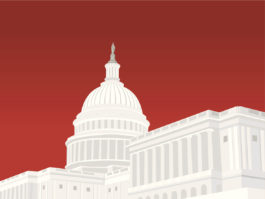In the midst of the COVID-19 crisis, many Americans are already experiencing economic hardship on account of the pandemic. Some are out of work or temporarily laid off, small businesses are struggling to stay afloat, and even our larger businesses are feeling the financial impact.
Congress, recognizing that Americans and our American economy are in troubling times and headed for further downturn, has been working around the clock to pass an unprecedented economic relief bill. On Friday, March 27, 2020, President Trump signed the $2.2 trillion Coronavirus Aid, Relief, and Economic Security Act (CARES Act) into law, immediately following its passing in the House.
The CARES Act is the largest stimulus package in U.S. History. “In effect, this is a wartime level of investment for our nation,” said Senate Majority Leader, Mitch McConnell. But representatives on both sides of the aisle recognize the urgency and importance in swiftly providing aid to the American people and our economy. “Today we’ve all acknowledged our nation faces an economic and health emergency of historic proportions due to the coronavirus pandemic — the worst pandemic in over 100 years,” said House Speaker, Nancy Pelosi. The House passed the bill with a voice vote, an unusual method chosen on account of the coronavirus.
The anticipated economic effects alone from this bill seemed to prompt positive changes in the stock market. The Dow Jones industrial average rose 11.4% this past Tuesday, following 10 weeks of decline. On Friday, after 3 days of record gain, we saw a 4.06% drop, bringing us back below the bull-market threshold, as investors are questioning whether the aid provided will be enough to keep our economy out of the woods.
Where does the money go?
Under the CARES Act, recovery relief payments will go to more than 150 million households. Payments of $1,200 will be sent to individuals making up to $75,000 a year, and $2,400 payments will be sent to married couples making up to $150,000 a year, with an additional payment of $500 per child under the age of 17. Individuals making more than $75,000, but less than $99,000 a year, and couples making more than $150,000, but less than $198,000 a year, will still receive a stimulus payment at a decreased amount.
These payments are estimated to begin going out in approximately 3 weeks, but the terms of the Act show payments being made between now and December 31, 2020. How will the IRS determine your status? They will look at your 2019 return if filed, your 2018 return if you have not, or your Social Security Statement if neither year is on file. And if you previously provided electronic banking information to the IRS in 2018 or 2019, it is possible your payment will be received electronically.
The Act also includes $100 billion in assistance for hospitals, $150 billion for state and local stimulus, and establishes a $500 billion lending fund for industries, cities, and states. This lending fund was a bone of contention between Republicans and Democrats, but, after negotiations on including oversight to monitor and minimize fraud, bipartisan agreement was reached on keeping the lending fund in the bill.
In addition, the bill expands unemployment insurance by $250 billion, expands eligibility, including self-employed and contract workers, and increases the weekly payments unemployed workers receive by $600 per week for the next 4 months.
The CARES Act also establishes a $349 billion loan program for small businesses. For information on the program and eligibility, we are publishing a separate, comprehensive article on the Paycheck Protection Program.
Individual Tax Relief
The April 15, 2020 federal tax filing deadline was previously extended to July 15, 2020, and is now automatically extended without incurring penalties and interest. Any 2019 federal tax payments due are also extended to July 15, 2020, and will not incur penalties and interest. The due date for payment of federal first quarter estimated taxes was also previously extended to July 15, 2020, and will not incur interest and penalties. This past week, Maine announced that returns and payments of taxes will also be due on July 15, 2020.
For coronavirus-related withdrawals of up to $100,000 for a 180-day period from a qualified retirement account, the CARES Act also waives the 10% early withdrawal penalty. It additionally sets recontribution terms and expands certain retirement plan loan eligibility.
The 2020 rules on charitable contributions have also changed, with the CARES Act suspension of the 50% of Adjusted Gross Income (AGI) limitation. It also includes a charitable deduction of up to $300 for certain deductions made by taxpayers that do not itemize their deductions when filing their return.
Business Tax Relief
The due date for the required payment of 6.2% of the employer’s portion of Social Security tax on employees’ wages is deferred, with payments made over a two year period. The initial payment of 50% will be due December 31, 2021, and the remaining 50% will be due on December 31, 2022.
Businesses that have suspended operations, or those now closed entirely, due to COVID-19 that are still paying workers will be eligible for the Employee Retention Credit, a credit for employment taxes. The credit is 50% of qualified wages, limited to $10,000 per employee, paid during this time.
To increase liquidity for businesses, Net Operating Loss (NOL) and Alternative Minimum Tax (AMT) terms are changing temporarily. By amending returns, corporate taxpayers may carryback a loss from 2018, 2019, or 2020, and the 80% limitation that came with the Tax Cuts & Jobs Act of 2017 (TCJA) has been suspended. The CARES Act sets up pass-through businesses to receive NOL benefits as well, as it extends the effective date of the TCJA limitation on non-corporate taxpayer deductions from a pass-through to tax years beginning after December 31, 2020. And, while the TCJA also eliminated AMT, the CARES Act includes a provision for companies to immediately claim a refund for AMT credit.
Beginning in 2018, the TCJA limited the business interest deduction to 30% of the taxpayer’s AGI. For 2019 and 2020, the CARES Act increases that limitation to 50%.
Businesses can also expect changes regarding charitable contributions and deductions. The limitation of 10% of taxable income for charitable contributions is set to increase to 25%, and the charitable deduction for food contributions is expected to increase from 15% to 25%.
The CARES Act also brings about several highly-anticipated technical corrections to the TCJA legislation. The Act includes Qualified Improvement Property (QIP) within the realm of property qualified for bonus depreciation, enabling much-needed write offs for business improvement costs. Companies that overpaid while making an annual mandatory repatriation installment, as set forth by the TCJA for untaxed foreign earnings, have been unable to receive refunds on overpayment while in active repayment. This bill allows for immediate requests for repayment of these overpaid funds. The TCJA legislation brought about additional confusion and requirements on constructive ownership, an additional area the CARES Act will address.
Stay tuned…
We expect the terms and reach of the CARES Act to continue to become clearer over the coming days and weeks. ARB is dedicated to updating our clients and community as the CARES Act and other implications of the COVID-19 pandemic continue to unfold. For additional considerations and questions on this information, contact us today.
by David Jean, CPA, CCIFP, CExP





